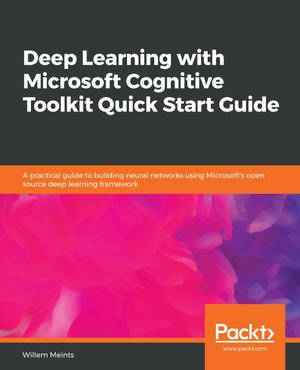
Deep Learning with Microsoft Cognitive Toolkit Quick Start Guide
A practical guide to building neural networks using Microsoft's open source deep learning framework
By: Willem Meints
eText | 19 August 2804 | Edition Number 1
Sorry, we are not able to source the ebook you are looking for right now.
We did a search for other ebooks with a similar title, however there were no matches. You can try selecting from a similar category, click on the author's name, or use the search box above to find your ebook.
Why choose an eTextbook?
Instant Access *
Purchase and read your book immediately
Read Aloud
Listen and follow along as Bookshelf reads to you
Study Tools
Built-in study tools like highlights and more
* eTextbooks are not downloadable to your eReader or an app and can be accessed via web browsers only. You must be connected to the internet and have no technical issues with your device or browser that could prevent the eTextbook from operating.
Learn how to train popular deep learning architectures such as autoencoders, convolutional and recurrent neural networks while discovering how you can use deep learning models in your software applications with Microsoft Cognitive Toolkit
Key Features
- Understand the fundamentals of Microsoft Cognitive Toolkit and set up the development environment
- Train different types of neural networks using Cognitive Toolkit and deploy it to production
- Evaluate the performance of your models and improve your deep learning skills
Book Description
Cognitive Toolkit is a very popular and recently open sourced deep learning toolkit by Microsoft. Cognitive Toolkit is used to train fast and effective deep learning models. This book will be a quick introduction to using Cognitive Toolkit and will teach you how to train and validate different types of neural networks, such as convolutional and recurrent neural networks.
This book will help you understand the basics of deep learning. You will learn how to use Microsoft Cognitive Toolkit to build deep learning models and discover what makes this framework unique so that you know when to use it. This book will be a quick, no-nonsense introduction to the library and will teach you how to train different types of neural networks, such as convolutional neural networks, recurrent neural networks, autoencoders, and more, using Cognitive Toolkit. Then we will look at two scenarios in which deep learning can be used to enhance human capabilities. The book will also demonstrate how to evaluate your models' performance to ensure it trains and runs smoothly and gives you the most accurate results. Finally, you will get a short overview of how Cognitive Toolkit fits in to a DevOps environment
What you will learn
- Set up your deep learning environment for the Cognitive Toolkit on Windows and Linux
- Pre-process and feed your data into neural networks
- Use neural networks to make effcient predictions and recommendations
- Train and deploy effcient neural networks such as CNN and RNN
- Detect problems in your neural network using TensorBoard
- Integrate Cognitive Toolkit with Azure ML Services for effective deep learning
Who this book is for
Data Scientists, Machine learning developers, AI developers who wish to train and deploy effective deep learning models using Microsoft CNTK will find this book to be useful. Readers need to have experience in Python or similar object-oriented language like C# or Java.
Read online on
ISBN: 9781789803198
ISBN-10: 1789803195
Available: 19th August 2804
Format: ePUB
Language: English
Publisher: Packt Publishing
Edition Number: 1
You Can Find This eBook In
This product is categorised by
- Non-FictionComputing & I.T.Computer ScienceArtificial IntelligenceNeural Networks & Fuzzy Systems
- Non-FictionComputing & I.T.Graphical & Digital Media Applications3D Graphics & Modelling
- Non-FictionComputing & I.T.DatabasesDatabase Design & Theory
- Non-FictionComputing & I.T.Computer ScienceHuman-Computer InteractionInformation Architecture
- Non-FictionComputing & I.T.Computer ScienceComputer Architecture & Logic Design
- Non-FictionComputing & I.T.Computer ScienceArtificial Intelligence























